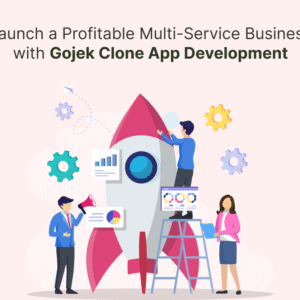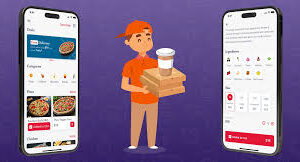The ride-hailing industry has been growing steadily, offering entrepreneurs an excellent opportunity to start their own businesses. Platforms like Uber have revolutionized the way people travel, making it more convenient, affordable, and safer to get a ride whenever needed. If you’re thinking about launching your own ride-hailing service, using an Uber-like app is a smart and efficient way to enter the market. These clone apps come pre-built with most of the necessary features, but customization is key to creating a unique and competitive app that can cater to your specific business needs.
In this blog, we’ll guide you through the process of customizing an Uber-like app for your ride-hailing startup, so you can stand out in the competitive market and meet your customers’ expectations.
Why Customize an Uber-Like App?
1. Unique Brand Identity
By customizing the app, you ensure it reflects your brand’s personality and values. From logo placement to color schemes, every detail can contribute to creating a unique identity that distinguishes your business from others in the market.
2. Tailored Features
Not all ride-hailing businesses have the same needs. Whether you want to target a specific market segment, offer additional services like food delivery, or implement unique booking options, customization allows you to cater to your specific customer base.
3. Improved User Experience
A customized Uber-like app can optimize the user experience by removing unnecessary features and focusing on what your target audience needs. A simpler, more intuitive app can lead to greater customer satisfaction and loyalty.
4. Competitive Advantage
A generic app may not offer the flexibility or functionality needed to stay ahead of your competition. Customizing your app allows you to add innovative features that can give your startup a competitive edge in the crowded ride-hailing market.
Steps to Customize Your Uber-Like App
1. Understand Your Target Audience
The first step in customizing an Uber-like app is to understand your target audience. Who are you trying to serve? Are you targeting local commuters, tourists, corporate clients, or a niche market? The more specific you are about your target audience, the easier it will be to decide on the features and design elements that resonate with them.
For instance, if your primary customers are tourists, you might want to integrate features like multi-language support and city guides. Alternatively, if you are targeting business professionals, you may need to focus on premium features such as business-class ride options, Wi-Fi, and in-app payment integration.
2. Choose the Right Features for Your Business
While Uber-like apps come with a basic set of features, you may need additional functionalities to suit your business model. Here’s a breakdown of the essential features you can customize in your app:
a. User Features
- Sign-Up and Login: Allow users to sign up and log in through social media accounts or email addresses for convenience.
- Ride Booking: Let users choose their ride type (economy, premium, XL, etc.), pickup and drop-off locations, and additional options like car seats, pet-friendly rides, etc.
- Real-Time Tracking: Enable users to track their ride in real-time, helping them stay updated on the driver’s location and arrival time.
- Payment Integration: Offer multiple payment options such as credit cards, digital wallets, and cash on delivery.
- Push Notifications: Send notifications for ride confirmations, driver arrivals, payment receipts, promotions, etc.
b. Driver Features
- Driver Registration: Customize the driver registration process, which could include submitting background checks, vehicle information, and document verification.
- Ride Notifications: Customize the way drivers receive ride requests, allowing them to choose whether to accept or reject a ride.
- Navigation & Route Optimization: Integrate GPS for real-time navigation and suggest the quickest routes, helping drivers provide timely service.
- Earnings Tracker: Include a feature for drivers to track their earnings in real-time, providing transparency and motivation to continue working.
c. Admin Panel Features
- Manage Drivers and Users: As an admin, you’ll need a dashboard to manage both drivers and users. Customization can include features like verifying driver documents, reviewing user ratings, and handling disputes.
- Real-Time Monitoring: Admins can monitor the status of all ongoing rides, track driver performance, and ensure smooth operations.
- Revenue Management: Keep track of all financial transactions, including user payments, driver payouts, and commissions.
- Promotions and Discounts: Customizable options for creating promo codes, special discounts, or loyalty programs to retain users.
3. Design and User Interface Customization
The look and feel of your app are crucial for user retention. Customizing the design will help make your app stand out and improve user engagement. Here are some design elements you can work on:
- Branding: Ensure that your app design incorporates your brand’s logo, colors, and fonts consistently throughout.
- Simple Navigation: Keep the user interface clean and easy to navigate. Whether users are booking a ride or checking their ride history, they should find it intuitive.
- Attractive Visuals: Use high-quality images, icons, and animations to make the app visually appealing.
- Customizable Themes: Provide users with the ability to customize some aspects of their experience, such as choosing a dark or light mode.
4. Add Extra Features Based on Market Needs
Customization offers you the opportunity to add features that give your app a unique edge. Depending on the niche you’re serving or the market you’re entering, consider integrating these advanced features:
- Ride Pooling: Let users share rides with others going in the same direction, reducing costs and offering a more eco-friendly solution.
- Car Rental Services: If your startup plans to offer more than just taxi rides, consider integrating car rental services as an additional revenue stream.
- Food Delivery: You could also branch out into food delivery by adding a food delivery option, similar to Uber Eats, giving you more market opportunities.
- Cashless Tipping: Allow users to tip their drivers directly through the app for better convenience.
- Ride Scheduling: Let passengers schedule rides in advance, especially useful for airport transfers or business meetings.
5. Ensure Robust Security and Privacy
Security and privacy are paramount when handling sensitive data, such as payment information and personal details. Make sure your Uber-like app is equipped with:
- SSL Encryption: Protect all communications between the app, users, and servers.
- Payment Gateway Integration: Secure integration with trusted payment gateways like Stripe, PayPal, or Razorpay.
- Two-Factor Authentication (2FA): Offer an extra layer of security for both users and drivers by implementing 2FA during login.
- Data Protection: Ensure compliance with data protection regulations like GDPR to protect users’ personal and payment data.
6. Test and Launch
Before launching your customized Uber-like app, ensure that it undergoes rigorous testing. Test all features for functionality, security, and usability. Once you’re confident in the app’s performance, you can launch it on app stores like Google Play and the Apple App Store.
7. Market Your Ride-Hailing Startup
After your app is live, marketing is key to attracting users and drivers. Use digital marketing techniques such as social media advertising, SEO, content marketing, and referral programs to promote your app. Ensure that you target the right audience and create attractive offers to get users onboard.
Conclusion
Customizing an Uber-like app is a strategic way to create a successful ride-hailing startup. With the right features, design, and functionality tailored to your target audience, you can create a competitive app that stands out in the crowded market.
To ensure the success of your app, partnering with a reliable app development company is crucial. These companies specialize in building and customizing on-demand apps, and they can provide the expertise and support necessary to create an app that meets both your business goals and user expectations. By working with an experienced development team, you can build a feature-rich and user-friendly app that helps your startup thrive in the fast-growing ride-hailing industry.










